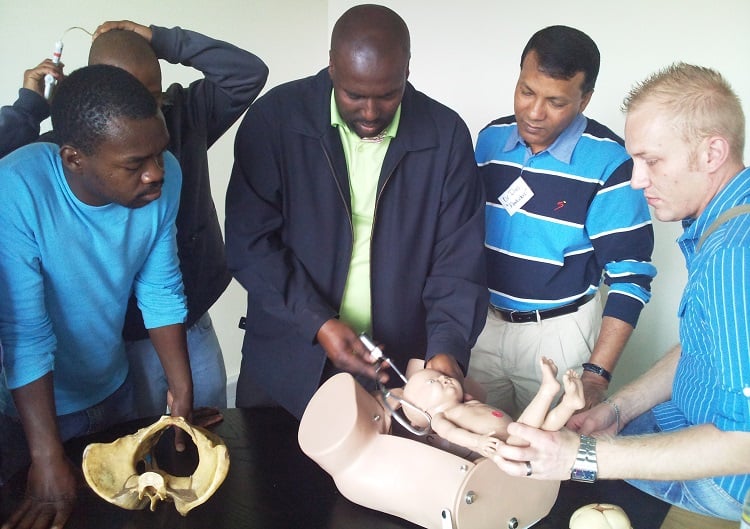Posted on October 04, 2017
Prof Robert Pattinson started his career in medicine working in a mission hospital in KwaZulu-Natal in the late 1970s. The doctor in charge was an old man suffering from Parkinson's disease. Despite his illness, this doctor served the community in a significant and selfless way. This commitment to improving the lives of poor South Africans inspired Pattinson so much that he decided never to ask people for money for medical services, eliminating any possibility of a comfortable life in private practice. Pattinson was particularly drawn to the medical field of obstetrics and gynaecology as it was in this field that he felt he could make a significant difference.
Nearly 40 years later, Pattinson is still committed to making a significant contribution in the lives of pregnant women, new-born babies and infants at the primary and secondary health care levels.[1] Pattinson is the director of the South African Medical Research Council's Maternal and Infant Health Care Strategies Unit in the Department of Obstetrics and Gynaecology at the University of Pretoria (UP), which was established in 1997. The focus of the unit echoes Pattinson's, seeking solutions for the primary and secondary health care levels that are saleable and sustainable. 'By seeking, we mean performing research; by saleable we mean solutions that are acceptable to all namely women, health care workers and health administrators; and by solutions we mean health strategies that have been developed to solve the problems identified,' says Pattinson.

Soon after the unit was opened, the National Committee for Confidential Enquiry into Maternal Deaths (NCCEMD) was established. The NCCEMD is a national process, working in collaboration with the unit to tackle the numbers, common causes and avoidable factors associated with maternal deaths through improved recording and analysis of these deaths. Findings are published in triennial Saving Mothers reports and are widely distributed – particularly at the primary and secondary health care levels. One of the main objectives of these reports has been to highlight health districts that are performing poorly in order for health authorities to focus their attention on improving them. Pattinson is also the editor of these reports.
Report findings highlight preventable maternal deaths, which include non-pregnancy-related infections, such as HIV/AIDS, obstetric haemorrhage and complications of hypertension in pregnancy. These conditions comprise 66,7% of possibly and probably preventable maternal deaths, and with adequate knowledge and skills from healthcare providers, these factors can be significantly reduced, Pattinson explains.
Following the success of the Saving Mothers reports, the unit also produced the collaborative reports, Saving Babies (focusing on perinatal care) and Saving Children (focusing on the healthcare of infants and children up to 18 years that are admitted to paediatric wards). Common among these categories are the five major challenges in South Africa: pregnancy and childbirth complications, new-born illness, childhood illness, HIV/AIDS and malnutrition as a result of poverty.
The fact that most of these challenges are preventable is what led the unit to develop the Perinatal Problem Identification Programme (PPIP), a tool to make perinatal and maternal death audits easier. This tool enables district hospitals to identify the number of perinatal and maternal deaths, as well as their causes. The PPIP also identifies specific avoidable factors and provides workable solutions to reduce these deaths. The PPIP now forms part of a national programme of the Department of Health and 95% of all district hospitals are using it. 78% of all births in the public sector are audited through the programme.

The Child Healthcare Problem Identification Programme (Child PIP) is a similar tool for infant and child deaths and is used in about 70% of all South African hospitals admitting children. It also forms part of the national programme of the Department of Health.
All information in the Saving Babies and Saving Children reports is derived from the PPIP and the Child PIP national survey systems. These tools have been taken across South African borders and implemented around the world.
From the information provided by these national survey systems, the unit has been able to concentrate its research on developing effective interventions and mechanisms that require low or zero technology and are low-cost. An example of these is the world-renowned Kangaroo Mother Care (KMC) technique of caring for premature babies, which ensures skin-to-skin contact between the mother and the premature baby. This work has been led by Dr Anne-Marie Bergh who works in the research unit.
The KMC technique is a simple, low-cost technique that can be easily taught. It has become one of the key implementation strategies of the World Health Organisation (WHO) in the reduction of deaths of premature babies. The success of this technique lies in the skin-to-skin contact. The premature baby lies on the bare chest of the mother, which ensures the baby is kept warm. Pattinson explains that, physiologically, the mother concentrates heat to the area, making this method more effective than an incubator. Bacteria from the mother's chest is transferred to the baby and together with the antibodies from the breastmilk, the baby's immunity is able to grow, preventing infection to the infant. Easy breastfeeding is also facilitated with the KMC technique. 'This technique has a profound impact on the baby, reducing infections, improving survival and ensuring better bonding between mother and child,' says Pattinson. The KMC technique is now also used in countries such as Tanzania, Kenya, Uganda, Ghana, Indonesia, Bangladesh and China, and is endorsed by UNICEF and Save the Children.
The unit was also involved in the development of the UmbiFlow handheld device which assesses blood flow in the umbilical cord of unborn babies. Because it is low-tech and inexpensive, a lower level of health care provider can use it. This device has successfully reduced the number of still births in Mamelodi. 'The study is impressive in that it looks at women who, by currently used methods, would be considered clinically normal, but by using this method we were able to identify that they are not,' says Pattinson. 'This ultimately means that this simple handheld device is saving babies' lives.'
The study is going into nine other sites across the country to see if the UmbiFlow has the same efficacy in detecting if a foetus is at risk of stillbirth. This is made possible through funding from the Council for Scientific and Industrial Research (CSIR) and the Medical Research Council (MRC).
The unit is also leading a study involving five countries to see if these results are reproducible in other developing countries. 'If what we have shown in Mamelodi is reproducible, this will be a very powerful tool to prevent stillbirths,' says Pattinson. The WHO is funding this part of the study.

Another of the unit's success stories is Essential Steps in the Management of Obstetric Emergencies (ESMOE), a programme focused on improving the emergency management of pregnant women and their infants by using a training package for emergency obstetric care. From its research, the unit found that the emergency health care of sick mothers and babies was not adequate at the primary and secondary health care levels in the country. In collaboration with the Liverpool School of Tropical Medicine, the unit developed this training programme for health care professionals and students alike to improve this area of emergency care. ESMOE is aimed at being able to train people on a large scale, having major impact.
From the unit's previous studies, it acquired a pool of information about district hospitals and was able to rate the levels of mortality in each district, developing a scoring system of each district's performance. Twelve districts were identified as being in the greatest need of ESMOE. Twenty-nine months of training followed with 80% of health care workers involved in maternity care receiving training. This training proved to be a great success, with a 29,3% reduction in maternal deaths after training. The unit also reduced the mortality rate deaths due to people bleeding after or during pregnancy and high blood pressure during pregnancy by 17,5%. ESMOE has proved so effective that the European Union (EU) has enabled the unit to extend the programme from the original 12 districts to all 52 districts in South Africa.
UP has become a well-known name across all the districts of South Africa and is making a name for itself overseas, thanks to the South African Medical Research Council's Maternal and Infant Health Care Strategies Unit. But perhaps what is most noteworthy is the unit's ability to constantly identify real problems facing South African mothers, babies and children, and to find realistic solutions that work. In that lies the real power, and under the directorship of Prof Robert Pattinson, the unit is making a considerable difference at the primary and secondary levels of health care, not only in South Africa, but throughout the world.
[1] An overwhelming majority of health care provided to South Africans is at the primary and secondary levels, which is why the Unit's predominant focus is on improving health care at these levels.
Copyright © University of Pretoria 2024. All rights reserved.
Get Social With Us
Download the UP Mobile App